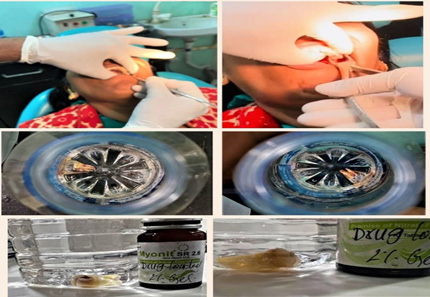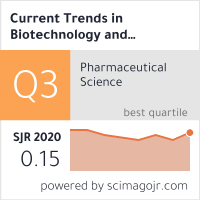Antimicrobial Study of Chitosan-Based Crosslinked Hydrogel Against Staphylococcus aureus, Porphyromonas gingivalis, Pseudomonas aeruginosa, and Streptococcus mutans
DOI:
https://doi.org/10.5530/ctbp.2023.3s.54Keywords:
Gingivitis, Antimicrobial, Metronida zole, Crosslinked Hydrogel, , PeriodontitisAbstract
Gingivitis is a pathogenic disorder caused by the growth of bacterial flora inside the gum cavity, also known as the gingival cavity. The formation of hard plaque is initiated by the deposition of a biofilm of microbes on the surface of teeth at the age of gums. These plaques, when developed, turn into tarter and are difficult to remove. These hard structures formed around the teeth caused severe damage to soft tissue and affected teeth, eventually causing permanent tooth loss. Gingivitis in an advanced stage, called periodontitis, causes permanent damage to the gum and teeth. Periodontal disease is caused by the bacteria Staphylococcus aureus, Porphyromonas gingivalis, Pseudomonas aeruginosa, and Streptococcus mutans. The aim of the investigation is to study how well chi-to-san-based crosslinked hydrogels containing Chlorhexidine, Metronidazole, and Lignocaine hydrochloride inhibit the growth of selected bacteria isolated from oral microbial flora such as Staphylococcus aureus, Porphyromonas Gingi valis, Pseudomonas aeruginosa, and Streptococcus mutans in vitro. Chitosan-based cross-linked hydrogel 2 % combined with all the active ingredients prepared and tested for antibacterial activity in SCAN-Laboratory Indrepuri, Bhopal. Bacterial samples were taken from freshly extracted teeth provided by District Hospital Raise in Madhya Pradesh, India, and then preserved in a saline solution. Isolate and culture each bacterium colony separately before performing an identification test for each of them. The hydrogel was then diluted at 25%, 50%, 75%, and 100% concentrations up to 10 power -9 to perform the antibacterial activity. All isolated bacteria colonies were separately cultured and introduced to a paper disc etched with antimicrobial gel. The media were then incubated in the incubator, and the (ZoI) Zone of inhibition was checked for the gel’s effectiveness. The mean diameter of the zone of inhibition against all isolated bacterial colonies was noticed to be in the 10-33 mm range, indicating the presence of strong anti-bacterial activity. A considerable qualitative difference (p = 0.000) was found between the inhibitory effects of each concentration of hydrogel on the bacteria Staphylococcus aureus, Porphyromonas gingivalis, Pseudomonas aeruginosa, and Streptococcus mutans. Because of the largest diameter of the inhibition zone, the most effective antibacterial activity was found in 2% chitosan-based hydrogels.



